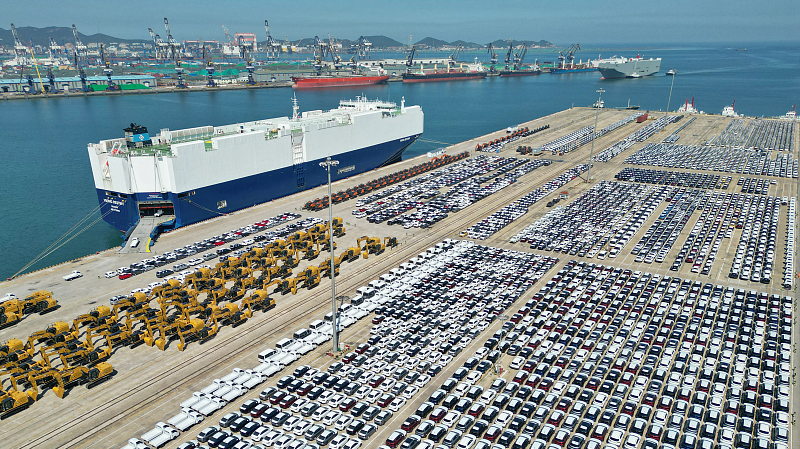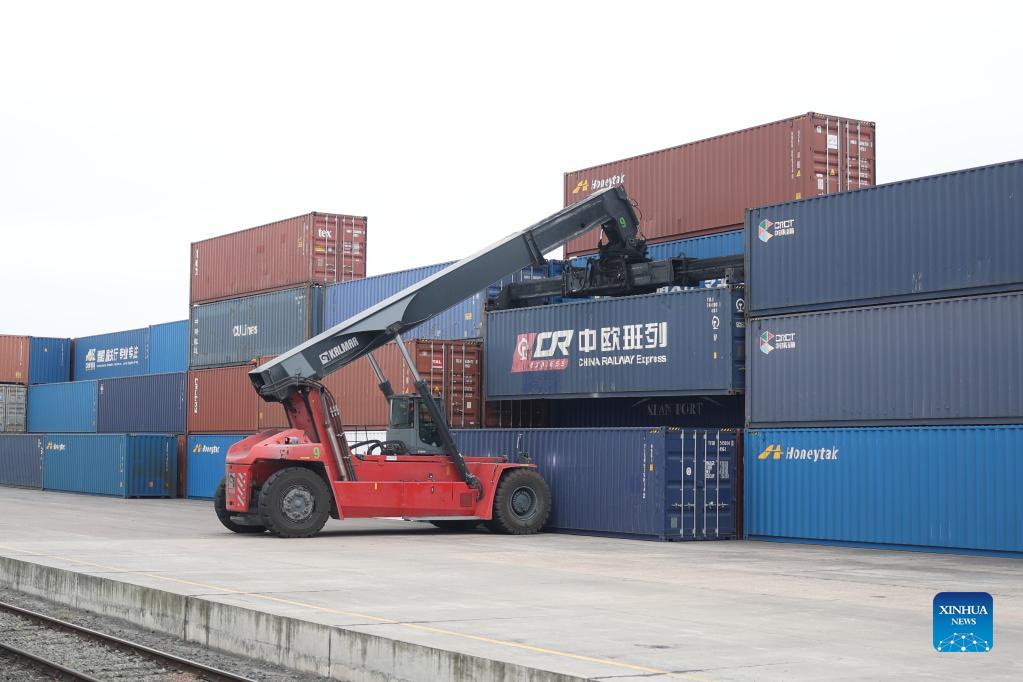
A port in Yantai, China's Shandong Province, September 7, 2022. /CFP
A port in Yantai, China's Shandong Province, September 7, 2022. /CFP
Editor's Note: He Weiwen is a senior fellow at the Center for China and Globalization. The article reflects the author's opinions and not necessarily the views of CGTN.
The sharp slowdown in Chinese August exports after robust month-on-month growth during May-July period, have aroused a general concern over the prospects for the remaining months of 2022. A more pessimistic assessment placed the August figures as the turning point for a weak future.
According to data released by the General Administration of Customs (GAC), the country's foreign trade totaled 3.71 trillion yuan ($531.64 billion) in August, up 8.6 percent on a yearly basis. In comparison, the month-to-month growth rate was 1.8 percent in July, 11.9 percent in June and 13.4 percent in May. The year-on-year growth rates were 15.3 percent in May, 22 percent in June, 23.9 percent in July and 11.8 percent in August, respectively.
Some analysts ascribed the sharp slowdown to the weakening of the world economy, with the JPMorgan Global Manufacturing Purchasing Managers' Index (PMI) falling from 51.1 in July to 50.3 in August, its lowest since June 2020.
The Ukraine crisis, high rising energy and food prices, the imminent sovereign debt crisis in a number of developing countries, and the worst inflation in 40 years entangling the U.S. and Europe, all have dampened the immediate prospects of the international economy.
In its July version of the World Economic Outlook, International Monetary Fund (IMF) scaled down the global GDP growth to 3.2 percent for 2022, and 2.9 percent for 2023. The report also warned that if the above-mentioned risks keep on, the growth rate might be even lower. The overall global economic risks and downward pressure will undoubtedly impact China's trade prospects for the rest of the year.
Nevertheless, the single monthly drop in August is not sufficient to justify any changes in the general trend. The August export and import deliveries were in general the performance of the contracts six months before and the PMI indicates the manufacturing performance six months later.
The direct reason is the exceptionally high growth rate in July. On the year-on-year (y-o-y) basis, the August trade was still 8.6 percent higher, with exports up 11.8 percent and imports up 4.6 percent. If we examine the three-year aggregate growth during 2019-2022, China's exports in August 2022 was 43.7 percent higher than that in 2019, while the July figure shows 47.3 percent growth over the past three years. The two figures are pretty close.
Hence, we have to follow the data for September and October to identify if a clear downward trend has appeared.
The August trade performances show wide disparities among major markets. Trade had come to a standstill with the U.S., remained stable with the EU and accelerated with the ASEAN. Total trade with the U.S. fell by 0.4 percent y-o-y, with exports up 0.4 percent and imports down 3.4 percent. It serves as a warning signal for China-U.S. trade. We have to be on the alert to watch closely if this trend continues into September and the fourth quarter, and if the overall China-U.S. trade enters into a steep drop.
China-EU trade in August shows a mild slowdown in China's exports (up 16 percent, compared to 19.7 percent during the first seven months), but a clear pick up in its imports from the latter, which was 7.7 percent up y-o-y, compared to 7.6 fall during the first seven months.

A staff member loads a cargo container to a train in Malaszewicze, Poland, October 15, 2021. /Xinhua
A staff member loads a cargo container to a train in Malaszewicze, Poland, October 15, 2021. /Xinhua
China-ASEAN trade accelerated in August with 21.0 percent growth over a year ago, compared to 13.1 percent, up during the first seven months. Chinese exports to ASEAN shot up by 30.5 percent (up 19.1 percent during the first seven months) and its imports from the latter increased by 9.6 percent (6.0 percent).
Among major export categories, the traditional labor-intensive categories still performed well. During the first eight months of 2022, textiles, apparel, shoes, ceramics and toys increased by 10.8, 12.8, 31.5, 8.9 and 21.5 percent, respectively.
Accordingly, China remains competitive in labor intensive productions. Among capital and technology-intensive categories, personal computer and mobile phones showed poor performances, up 2.8 and 3.5 percent respectively y-o-y. Color television and other home electrical appliances fell by 8.6 percent. Machinery for general purposes increased by 12.5 percent and semiconductor chips up 8.7 percent. Automotives became the fast- rising star, increasing 44.5 percent in quantity and 57.6 percent in value. It shows that China's export competitive advantages are shifting increasingly to higher-end products.
Looking ahead, the September trade performance will likely show a similar slowdown as in August, because of its high base. Chinese exports in September 2021 were even 5.0 percent higher than the previous month. Performances in the fourth quarter will be more indicative to a clear trend.
If the average monthly trade volume remains at the August level, total trade volume for the whole year 2022 will be 42 trillion yuan, with an annual growth rate of 7.8 percent, with exports up 10.4 percent and imports up 3.7 percent. We remain confident that the actual monthly data for the rest of the year will be higher than that in August. Hence, 2022 will see trade growth at around 10 percent, with two-digit level growth for exports and around 5 percent growth for imports.
China's net exports contributed 1.1 percentage points to GDP growth in the second quarter, 2020. A sound, stable trade growth will also contribute positively to GDP growth for the year.
We should implement all the measures of the State Council for supporting the import and export trade. We should analyze the trends and risks of the major markets, major product categories, and take necessary measures accordingly. We should uphold the reform and opening-up policy, making every effort to maintain trade growth with major trading partners.
China trade in 2022, despite all the external risks and difficulties, will continue to remain resilient and make good contributions to economic growth both in China and in the world at large.
(If you want to contribute and have specific expertise, please contact us at opinions@cgtn.com. Follow @thouse_opinions on Twitter to discover the latest commentaries in the CGTN Opinion Section.)

